Bedford
Victorian Super Sleuth Trail for Children
Places > Bedford > Victorian Super Sleuth Trail > Quiz 3 > 19th Century Buildings and Bridges in Bedford
19th Century Buildings and Bridges in Bedford
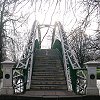 |
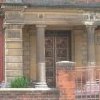 |
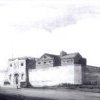 |
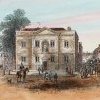 |
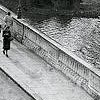 |
Bedford Suspension Bridge
The Suspension Bridge was
the first such bridge to be built in the county. John J. Webster built
the present structure in 1888 as part of the Embankment landscaping scheme: a
bridge was needed to link the Embankment with the newly purchased Mill
Meadows across the river. The bridge itself curves in an elaborate
bowstring with a lattice design and lined with girders, the deck is
concrete laid over iron plates. The structure is 6ft wide with a span
of 100ft.
The Bunyan Meeting House, Mill Street
This particular religious building has a long history with the
current church being the third meeting house to have stood on the
site. [John Bunyan was pastor at the earliest meeting house].
The Meeting
House features
bronze doors that were presented to the building in 1876 by the
Duke of Bedford. The doors are decorated with 10 beautiful panels
depicting scenes from The Pilgrim's Progress. The
interior of the church also features stained glass windows including the famous image of John Bunyan in gaol.
Bedford Old Town Hall, St Paul's Square
The Old Town hall - situated in St Paul's Square - was once the
former Grammar School endowed by Sir William Harpur and his wife
Dame Alice in 1566.The stone building was re-fronted in 1767 and a niche - featuring a
monument to Sir William Harpur - was added. The Grammar School moved to
the present Bedford School site in 1892
and the Bedford Corporation, who used it to create Bedford's first
town hall, purchased the building. The building is now used as
the town's Tourist Information Office.
John Bunyan's Statue
The statue was created by Sir Joseph Edgar Boehm and was a
gift to the town by the 9th Duke of Bedford. The unveiling of the
statue took place on 10th June 1874 by Lady Augusta Stanley to
much interest and fanfare from the public. The statue was crafted from
bronze that originated from China in the form of cannons and bells.
Bedford Prison
Plans for the current prison that now stands in St Loyes Street were
originally mooted by prison reformer John Howard. Work was finally
started in 1797 to replace the crumbling and decrepit building at
the junction of the High Street and Silver Street.
John Howard has left us an interesting picture of the old
prison he wrote: "In this prison there is on the first
floor, a day room for debtors and four lodging rooms; for felons
on the ground floor, two day rooms, one for men and the other for
women without fireplaces and two cells for the condemned."
The new prison was completed in 1801 and parts of this original
structure can still be seen today.
Bedford Bridge
The original bridge is said to have dated from 1224 and was
constructed using stone from Bedford Castle. It was
330 feet long and 13 and a half foot wide with a gatehouse at the end
of each centre arch - one of these was used as a gaol, which at one
time held John Bunyan.
Due to the onslaught of time and weather, the
bridge was gradually damaged, the worst being a severe flood in
167. in 1803, having been found to be unsound, an Act of
Parliament called for the entire bridge to be built. The new bridge
was completed in 1813 and was erected with the help of a
public subscription. A plaque - to commemorate the opening in 1813 -
can still be seen today.
Bedford Infirmary
Bedford philanthropist Samuel Whitbread, on his death, left a large
sum of money in his will to be put towards the building of an
infirmary (hospital) for the sick of Bedford. His son - also named
Samuel - fulfilled his father's wish with the creation of Bedford
Infirmary in 1803.
In 1844, the typhus epidemic that was sweeping
the country saw the erection of a fever hospital on the site to cope
with those infected. In 1899 a new County Hospital was erected on the
site of the old infirmary, which had become obsolete both in terms of
size and equipment.
Information taken from Bedfordshire Buildings and Monuments
Page last updated: 22nd January 2014
